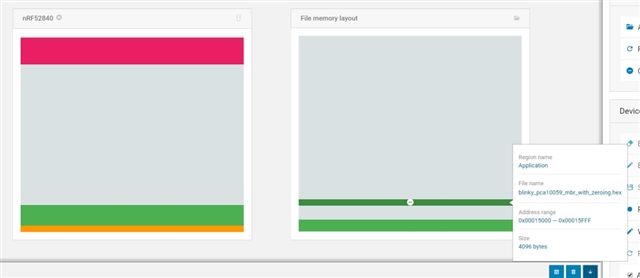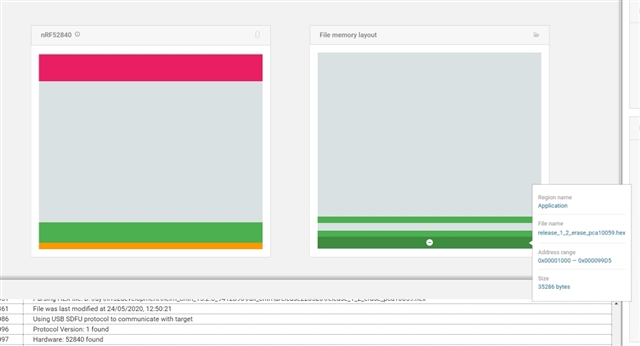Environment - windows 10, ses release 4.12 nRFconnect programmer 3.3.3 using gnu C nRF52840 dongle programming with DFU. No softdevice, Gazell only.
I have two hex files, one containing my nrf52840 dongle program and the other containing the program plus a section erasing 4k of memory from 15000
With the same difference between .hex files (but obviously not identical .hex files) using ses and Jlink on the PCA10056 dev kits, both .hex work just fine.
If I use nRFConnect v3.3.3 programmer to load the one containing just the program onto a dongle, all runs just fine.
If I use nRFConnect programmer to load the one which also erases the 4k of memory, the program does not run at all, when powering up the dongle it goes into bootloader mode without pressing the reset button.
.
They are built using ses. The only difference in the build is in the file "flash_placement.xml".
The only difference in that file is in the line:
<ProgramSection alignment="4" keep="Yes" load="No" name=".GZP_PARAMS" start = "0x00015000" size="0x1000" />
which is changed to:
<ProgramSection alignment="4" keep="Yes" load="Yes" name=".GZP_PARAMS" start = "0x00015000" size="0x1000" />
There is not a single character of difference in either the .map file or the section of the .hex file which contains the program.
The only difference in the hex file is a section which looks like:
:020000021000EC
:10500000FFFFFFFFFFFFFFFFFFFFFFFFFFFFFFFFB0
:10501000FFFFFFFFFFFFFFFFFFFFFFFFFFFFFFFFA0
:10502000FFFFFFFFFFFFFFFFFFFFFFFFFFFFFFFF90
:10503000FFFFFFFFFFFFFFFFFFFFFFFFFFFFFFFF80
:10504000FFFFFFFFFFFFFFFFFFFFFFFFFFFFFFFF70
*
*
*
:105FA000FFFFFFFFFFFFFFFFFFFFFFFFFFFFFFFF01
:105FB000FFFFFFFFFFFFFFFFFFFFFFFFFFFFFFFFF1
:105FC000FFFFFFFFFFFFFFFFFFFFFFFFFFFFFFFFE1
:105FD000FFFFFFFFFFFFFFFFFFFFFFFFFFFFFFFFD1
:105FE000FFFFFFFFFFFFFFFFFFFFFFFFFFFFFFFFC1
:105FF000FFFFFFFFFFFFFFFFFFFFFFFFFFFFFFFFB1
(I missed out a lot of them because they are boring).
The first line sets the start address and the subsequent lines fill them with FF.
Just to prove a point, if I edit out the above lines erasing the memory from the hex file and then use nrfconnect programmer to write the resulting .hex the program runs just fine.
If I write the program containing the erase, and then re-write it with the one without the erase, then it works just fine AND it looks like the erase actually worked i.e. I have to re-pair the client with the server dongle.
I then tried to edit out the application and keep JUST the erase commands - Ah, nRF connect knows better than me because it then asked me what soft device I wanted (that being none which wasn't allowed) and refuse to program the dongle unless I gave an answer.
Can anyone throw a light on just how to use nRFconnect programmer to set some memory to FFs in the region 15000 for 4K and actually have a working dongle.
If a Nordic employee is interested, I can send you the .hex files.
Regards, Ray Foulkes
PS - I do have some options still:
a) (assuming that nrfutil does not have the same limitations) switch to command line programming using some Bash scripting.
b) tell the end user to load the non-working program, then the working program and the pairing memory will have been erased - very amateurish but it works.
c) do what I have done for the device end - make it possible to erase 4K of memory when starting the dongle with finger on the button instead of just the device pairing record.
d) persuade Nordic to make a gui program that just does what it is told, and doesn't try to be over clever (or try to make one myself)
PPS, It would be REALLY, REALLY nice if someone could document the actual logic used by nRFconnect programmer in the user guide. It pretends to be able to load whatever you give it (it does not say otherwised) but it is blatantly not true, well, it might load it, but it somehow prevents it from running. I have spent a week trying to understand what was happening.
In order to save me much frustration and time, can someone answer the question "If I try to use the command line nrfutil will I simply hit the same obstacle (i.e. does nrfConnect programmer simply pass on the defects of nrfutil??) "




